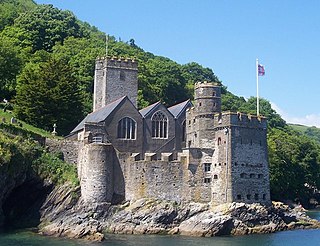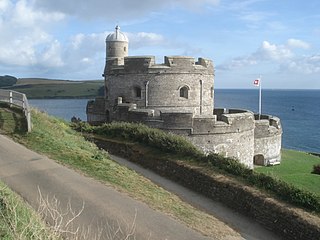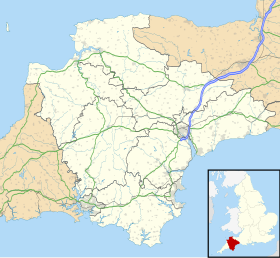
Dartmouth is a town and civil parish in the English county of Devon. It is a tourist destination set on the western bank of the estuary of the River Dart, which is a long narrow tidal ria that runs inland as far as Totnes. It lies within the South Devon Area of Outstanding Natural Beauty and South Hams district, and had a population of 5,512 in 2001, reducing to 5,064 at the 2011 census. There are two electoral wards in the Dartmouth area. Their combined population at the above census was 6,822.

The River Dart is a river in Devon, England, that rises high on Dartmoor and flows for 75 kilometres (47 mi) to the sea at Dartmouth.

PS Kingswear Castle is a steamship. She is a coal-fired river paddle steamer, dating from 1924 with engines from 1904. After running summer excursions on the River Medway and the Thames for many years she returned to the River Dart in Devon in December 2012 to run excursions from 2013 onwards on the river she was built on and for. Kingswear Castle is listed as part of the National Historic Fleet of ships of "Pre-eminent National Significance".

The Device Forts, also known as Henrician castles and blockhouses, were a series of artillery fortifications built to defend the coast of England and Wales by Henry VIII. Traditionally, the Crown had left coastal defences in the hands of local lords and communities but the threat of French and Spanish invasion led the King to issue an order, called a "device", for a major programme of work between 1539 and 1547. The fortifications ranged from large stone castles positioned to protect the Downs anchorage in Kent, to small blockhouses overlooking the entrance to Milford Haven in Pembrokeshire, and earthwork bulwarks along the Essex coast. Some forts operated independently, others were designed to be mutually reinforcing. The Device programme was hugely expensive, costing a total of £376,000 ; much of this was raised from the proceeds of the Dissolution of the Monasteries a few years before.

The Dartmouth Steam Railway, formerly known as the Paignton and Dartmouth Steam Railway, is a 6.7-mile (10.8 km) heritage railway on the former Great Western Railway branch line between Paignton and Kingswear in Devon, England. Much of the railway's business is from summer tourists from the resorts of Torbay, who travel to Kingswear, where the Dartmouth Passenger Ferry takes them across the River Dart to Dartmouth.
The Landmark Trust is a British building conservation charity, founded in 1965 by Sir John and Lady Smith, that rescues buildings of historic interest or architectural merit and then makes them available for holiday rental. The Trust's headquarters is at Shottesbrooke in Berkshire.

Kingswear is a village and civil parish in the South Hams area of the English county of Devon. The village is located on the east bank of the tidal River Dart, close to the river's mouth and opposite the small town of Dartmouth. It lies within the South Devon Area of Outstanding Natural Beauty, and has a population of 1,332, reducing to 1,217 at the 2011 census.

Dartmouth Castle is an artillery fort, built to protect Dartmouth harbour in Devon, England. The earliest parts of the castle date from the 1380s, when, in response to the threat of a French attack, the civic authorities created a small enclosure castle overlooking the mouth of the Dart estuary. This was intended to engage enemy ships with catapults and possibly early cannon, and incorporated the local chapel of Saint Petroc within its walls. At the end of the 15th century, the castle was expanded with an artillery tower and an iron chain which could be stretched across the harbour to a tower at Godmerock; this addition formed the oldest known purpose-built coast artillery fort in Britain. Further gun batteries were added during the French invasion scare of the 1540s.

St Mawes Castle is an artillery fort constructed by Henry VIII near Falmouth, Cornwall, between 1540 and 1542. It formed part of the King's Device programme to protect against invasion from France and the Holy Roman Empire, and defended the Carrick Roads waterway at the mouth of the River Fal. The castle was built under the direction of Thomas Treffry to a clover leaf design, with a four-storey central tower and three protruding, round bastions that formed gun platforms. It was initially armed with 19 artillery pieces, intended for use against enemy shipping, operating in partnership with its sister castle of Pendennis on the other side of the estuary. During the English Civil War, St Mawes was held by Royalist supporters of King Charles I, but surrendered to a Parliamentary army in 1646 in the final phase of the conflict.

Bayard's Cove Fort, also known historically as Berescove or Bearscore Castle, is an English 16th-century artillery blockhouse, built to defend the harbour entrance at Dartmouth in Devon. Constructed in the early part of the century, it had eleven gunports for heavy artillery and was intended to engage enemy vessels that broke past the external defences of the Dartmouth and Kingswear castles. It remained armed during the English Civil War, but was neglected in the 18th century and used for storage. The fort was restored in the late 19th century and is now managed by English Heritage and open to visitors.

Salcombe Castle or Fort Charles is a ruined fortification just off the beach of North Sands in Salcombe, Devon, England, within the South Devon Area of Outstanding Natural Beauty. It is located on a rocky outcrop which is easily reached on foot at low tide. It is a Grade II listed building and ancient monument.

Cromwell's Castle is an artillery fort overlooking New Grimsby harbour on the island of Tresco in the Isles of Scilly. It comprises a tall, circular gun tower and an adjacent gun platform, and was designed to prevent enemy naval vessels from entering the harbour. The castle was built in two phases; Sir Robert Blake constructed the tower between 1651 and 1652 in the aftermath of the Parliamentary invasion of the islands at the end of the English Civil War, and Master Gunner Abraham Tovey added the gun platform during the War of Jenkins' Ear around 1739. The tower fell into disuse soon afterwards, and in the 21st century is managed by English Heritage and open to visitors.

River Link is a ferry, cruise boat, and bus operator, based in Devon, England. The company is owned by Dart Valley Railway plc, who also own and operate the Dartmouth Steam Railway.
The MV Edgecumbe Belle is a single screw passenger vessel, operating from Mt Edgcumbe and Stonehouse Plymouth running 7 days a week half hour service also carrys Marley the ferry dog.
The River Dart Steamboat Co Ltd (RDSC) and its predecessors, the Dartmouth Steam Packet Company and the Dartmouth and Torbay Steam Packet Company, were the major ferry and excursion boat operators on the River Dart in South Devon for 120 years, until the company's demise in 1976. The company was famous for its distinctive paddle steamers, which were a familiar sight on the river until the late 1960s.

Dart Lifeboat Station is the base for Royal National Lifeboat Institution (RNLI) search and rescue operations at Dartmouth, Devon in England. The present station was opened in 2007 although an earlier lifeboat was stationed in the town from 1878 to 1896. It operates a D class (IB1) inshore lifeboat (ILB).

NCI Froward Point is a busy National Coastwatch Institution (NCI) lookout station at Inner Froward Point at the easterly side of the mouth of the River Dart two miles by coast path from Kingswear in Devon in England. Its twin duties are to maintain an hours of daylight watch over the local coastal area and the South West Coast Path on whose route it lies. With some significant blind spots because of the coastline, NCI Froward Point covers the coastline from Start Point in the West towards Brixham in the East.

Dartmouth Harbour is a natural port located in Dartmouth, Devon, England. It is situated at the mouth of the River Dart on the English Channel. Bayard's Cove Fort is a small fort, which was built to defend the harbour's entrance. The crafts which dock at the port are mainly local fishing vessels, naval ships and luxury yachts; warships routinely visit the harbour. The River Dart is navigable from Dartmouth to the old weir location at Totnes.
Bryan Hugh St. John O’Neill, was Chief Inspector of Ancient Monuments in the Ministry of Works. In 1939 he married Helen Donovan of Bourton-on-the-Water, daughter of Charles Donovan MD, who was noted for her work on Gloucestershire archaeology. As an Inspector of Ancient Monuments he wrote or commissioned authoritative guide books to ancient monuments of all periods. He specialised in medieval castles. One of the guide books he wrote was on Dartmouth Castle, where the ‘Guntower’ building of 1481 and 1495 is the earliest surviving English coastal fortress specifically built to carry guns. This gave him a great interest in the development of early artillery fortification, in which he became a leading expert. His book Castles and Cannon; A study of Early Artillery Fortifications in England, has become a standard work. This was published in 1960, six years after his premature death at the age of 49. He also wrote on the coastal castles of the Gold Coast as well as studying the defences of Tangiers and Rhodes.

Sir John Henry Seale, 1st Baronet (1780–1844) of Mount Boone in the parish of Townstal near Dartmouth in Devon, was a Whig Member of Parliament for Dartmouth in 1838. He was created a baronet on 31 July 1838. He owned substantial lands in Devon, mainly at Townstal and Mount Boone. Together with the Earl of Morley of Saltram House near Plymouth, he built several bridges in Dartmouth, most notably the Dart crossing. Arthur Howe Holdsworth's, the previous Member of Parliament in Dartmouth, influence over the pocket borough of Dartmouth ceased after the 1832 Reform Act and subsequently he was in competition for that parliamentary seat with John Seale, who won the seat.


















